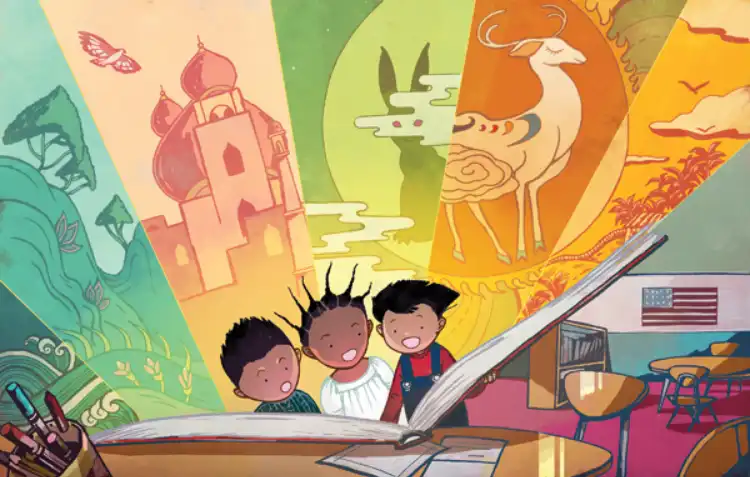Children’s literature even in its simplicity is a complex art and has been with sand of times inside an hourglass moulding to adorn society. Tracing back to history might validate that definition of childhood has sculpted the literature design for children. During the age of enlightenment, children were considered miniature adults, so childhood was not neglected; it was non-existent.
In 1693, John Locke’s book Some Thoughts Concerning Education proposed the idea of books for children. In the puritan age, children’s book was a doctrine enshrined to obey as it came from the belief that children are wicked and must be saved. John Newbery, the father of children’s literature made it a part of the literary Market. At times literary figures attempted to dust away the confusion about children’s literature. The essay, children literature: theory and practice by Felicity Hughes; Hughes argue children’s literature when compared to main-stream literature is inferior is a notion. The definition of childhood has polished children’s literature for decades. One candle ignites other, and the world gets enlightened, so it would not be wise not to consider matter that speaks of childhood in the school curriculum.
The modern-day has accepted childhood as a crucial developing state of an Individual. The Neurological and cognitive shreds of evidence pushed children’s minds in red circles based on development spectrums. Overall development includes self-awareness and social/Cultural awareness. Self-awareness and social awareness are interlinked and share cause-and-effect relationships. Children’s Literature brings all these development spectrums under one umbrella enabling Individuals to access the learning-optimization key. Exposing children to quality literature enriches Language Development, Empathy, Critical Thinking, Values, Reading, and Cultural Awareness.
Kids’ cognitive erudition
Language development from cooing till schooling
Piaget, Vygotsky, and Erik Erikson’s theory of cognitive development studies have mentioned language development. The branch of linguistics called psycholinguistics has paid attention to language acquisition. Noman Chomsky has concluded language acquisition is a biologically determined process. All the studies and theories hence prove language learning should be a part of kids cooing stage followed till their schooling. Daily Interaction based on stories and pictures in the child’s cooing stage can result in diction building adding upto language development. Children’s literature is the device to accomplish the significant task for malleable minds.
Reading is a mandate in kids’ life
Reading is a tool for emotional purgation, mostly propagated in a scholarly term as catharsis. Children Understanding of the world through second perspectives makes them aware of emotions. Children’s books stir sufficient background and foreground moments for kids to express their sentiments. Children’s literature opens a room of practice that involves accepting feelings by simply relating to the text. Reading can act as a barrier between emotion and emotional dysfunction. Any form of emotional repression/ dysfunction hinders the stable development of the mind.
Kid’s psychology and impact of learning through text
MM Bakhtin has earlier, that language is an act of communication within a socialized group based on abstraction that must be accessible to the reading audience. Text-book reading is one aspect of language development. Umberto Eco’s analysis of the book’s relationship with the audience; Umberto focuses on readers’ literacy understanding. Readers’ literacy understanding of books is of two kinds, First comes Intentional readership, and second is Authorial design. Intentional readership is readers’ authority over understanding the text; Authorial design is the subtle ways to mend the text to convey the author’s intentions, and Often Didactic or Moral stories result from Authorial design. Personal response theory is a process of interpretation and building a connection with the text according to the audience’s perspective. Personal response theory often takes a back seat in didactic writing. Text-based on Authorial design can be perceived in numerous ways. Children’s literature Didactic orientation nullifies kids’ ability to a personal response. The targeted audience, children have an undeveloped literary competence. Concerning children, it becomes significant to show them where texts are supposed to lead or what is the moral under the guidance of then and that time supervisor, and at times these supervisors are parents or teachers.
Constrained didactic teaching guided by personal response theory creates values. Textual learning improves readers’ literacy understanding. There is no illusion that children‘s Literature undeniably includes an educational component, this may not be necessarily moralistic or didactic.
Children’s literature can be an Adobe for creating responsible Adults. Inside stories, Narration is a pseudo experience providing space for empathy and critical thinking. Children become mindful of real-life situations. In picture theory by WJT Mitchell, the comparative analysis images are as powerful as the text. The use of picture books represents reality to a variant degree of Imagination, which makes children react to pictures in a profoundly humane way. Children’s literature is a medium of literary and general education that governs overall cognitive development.
Before children’s literature reaches the school gate, the Initial phase of implementing this idea should weigh on the bars of what kind of children’s literature is suitable for education. The best suit for the purpose is literature that balances literary quality and educative evocativeness.


